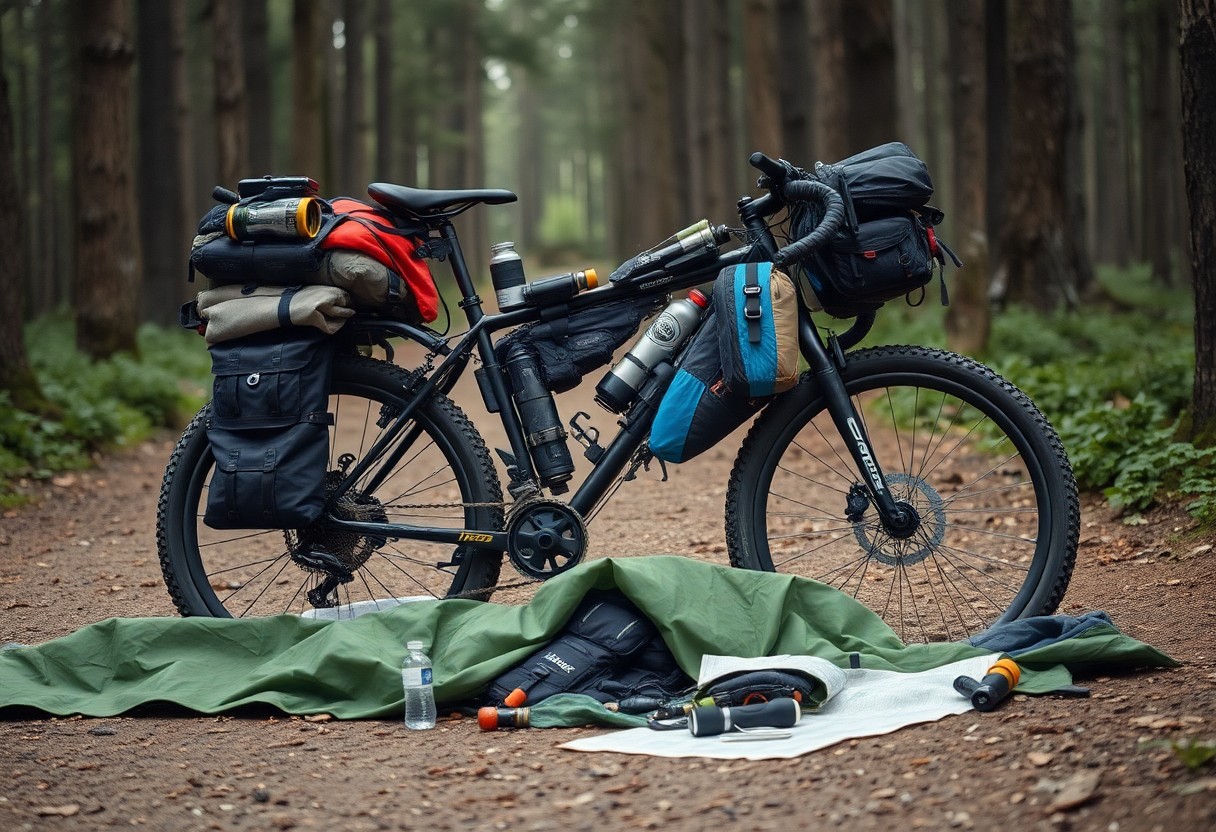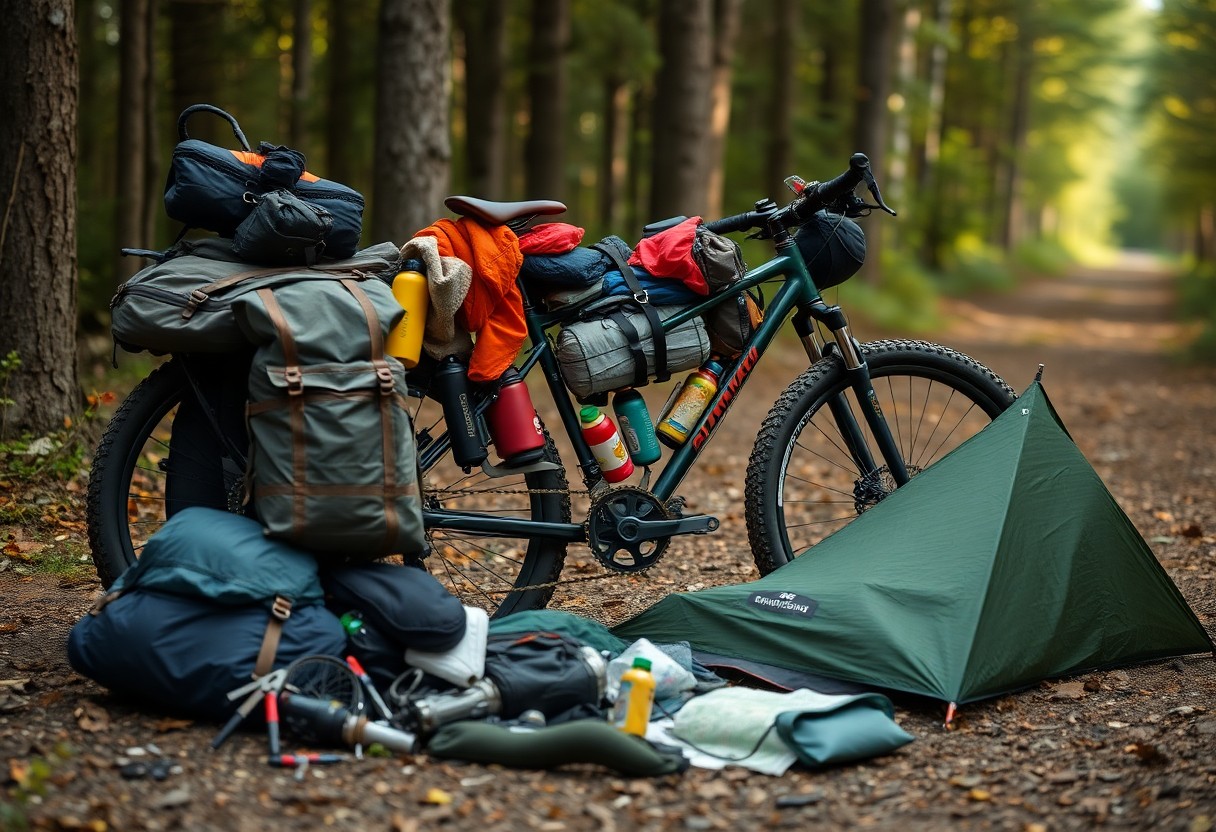You may think that bikepacking is simply about pedalling through stunning landscapes, but it can also be fraught with unexpected challenges. Learning from your errors is necessary to having a safe and enjoyable adventure. In this post, I will share five key mistakes I made on my first trip that could help you avoid similar pitfalls. This isn’t just about the joy of exploration; it’s also about being prepared and making informed choices to ensure your journey is both memorable and secure.

The Gear Trap: Overpacking and Unnecessary Items
Raiding your local outdoor store may feel exciting, but overpacking can turn a dream bikepacking trip into a burdensome chore. You might find yourself lugging around gadgets that seemed appealing at home but serve little purpose on the trail. Each extra item adds weight and reduces your efficiency, making your journey less enjoyable. Understanding what you truly need versus what looks good on paper can save you from breaking your back while pedalling through picturesque landscapes.
Identifying the Essentials vs. Luxuries
Every item you pack should justify its weight. Essentials, such as a water filter, first aid kit, and lightweight cooking gear, serve a functional purpose, while luxuries, like a fancy camp chair or an extra pair of shoes, often take up valuable space without contributing to your survival or comfort. Prioritising practicality helps you focus on what’s vital for your journey.
Strategies for Minimising Weight and Maximising Efficiency
Streamlining your kit effectively reduces weight while enhancing your experience. Consider opting for multi-functional tools that replace several items, such as a pot that doubles as a pan. Additionally, invest in lightweight, high-quality gear designed specifically for bikepacking. Lastly, test your setup before hitting the road to identify unnecessary items—what might seem crucial in theory can often be left behind in practice.
Choosing gear wisely involves evaluating both the weight and usefulness of every item. For instance, replace bulky cooking systems with compact, streamlined alternatives that still allow for nutritious meals. You may also find that drying towels can be swapped for bandanas, functioning efficiently at a fraction of the weight. Joining online forums can provide insights into gear recommendations from seasoned bikepackers, enabling you to make informed decisions that suit your specific needs without the burden of excess.
Route Planning Gone Wrong: Ignoring Terrain and Conditions
Neglecting to consider terrain and weather conditions can lead to dire consequences on your bikepacking trip. Opting for a flat, direct route without understanding its gravel patches or steep climbs may leave you exhausted and frustrated, especially if unexpected rain turns trails into mud. Researching your route thoroughly, including elevation maps and weather forecasts, will ensure you make informed decisions that accommodate your abilities and preferences.
The Consequences of Poor Research
Skipping detailed research can lead to a myriad of problems, from physical exhaustion when tackling unanticipated hills to equipment failure caused by ill-suited trails. For instance, choosing a deeply forested route without understanding its potential for getting lost or finding no access points could leave you stranded and unprepared. Awareness of your surroundings is critical.
Tools and Resources for Proper Planning
Utilising maps, apps, and local expertise can transform your planning process. Resources like AllTrails and Komoot offer detailed route information and user-generated insights that help identify reliable paths, while local cycling communities provide invaluable advice on current trail conditions. Don’t overlook printed maps either; they can offer a broader overview of the geography.
Enhancing your planning toolkit might involve investing in navigation apps, such as Strava or Ride with GPS, which allow customised routes based on your preferences. Incorporating weather apps into your planning can save you from sudden downpours that lead to treacherous conditions. Additionally, joining online forums or local cycling groups can provide firsthand accounts of trail status and tips that you won’t find elsewhere. The combination of digital tools and community input ensures that your routes suit your skills and expectations.
Hydration Headaches: Underestimating Water Needs
Running out of water in the wild isn’t an adventurous twist; it’s a hazardous mistake. Opting for a day of riding without adequate hydration planning can lead to fatigue and lowered performance, not to mention the serious health risks of dehydration. During my first bikepacking trip, I realised far too late that my water reserves were insufficient for the distance and conditions I faced. Your body relies heavily on being properly hydrated, especially when exerting itself in hot or dry climates, so don’t overlook this imperative aspect of preparation.
Understanding Hydration Requirements
Your hydration needs can vary significantly based on various factors such as climate, physical exertion, and personal physiology. It’s recommended that you consume around 2 to 3 litres of water daily while cycling, and even more in warmer conditions. Pay attention to your body’s signals, as signs of dehydration include headaches, dizziness, and decreased performance, which are all signs that you need more fluids.
Solutions for Efficient Water Sourcing on the Trail
Finding water while bikepacking can enhance your experience and reduce your load. Use a combination of reliable sources, such as water purification tablets, to ensure safety when drinking from streams or lakes. Carrying a lightweight filter can also ease the concern of sourcing water on the go, allowing you to refill without worry. Additionally, make use of established water points along your route, like campsites or trailheads, to top up your supplies regularly.
Establishing a strategy for water sourcing will make a significant difference on your journey. You can carry a collapsible water container easily strapped to your bike for emergencies or refill at natural springs or taps encountered along the trail. Planning your route to include known water sources will minimise the risk of running dry. Implementing water acquisition filters or purification systems can also guarantee that you consume safe water, keeping you hydrated without compromising health. Always scout and note reliable locations during your trip preparation to ease your worries when you hit the trail.
Navigational Nightmares: Relying Solely on Technology
Your reliance on technology can become a double-edged sword during bikepacking. I faced a disorienting night when my GPS failed to load, leaving me stranded amidst unfamiliar terrain. You may find yourself on a well-trodden path one moment and utterly lost the next if you solely depend on your phone or other digital devices. Without a reliable backup plan, navigating through unexpected detours can swiftly escalate into a navigational nightmare.
The Pitfalls of Digital Dependence
While apps and gadgets offer a convenient way to navigate, they can easily lead to misadventures. Battery depletion, lack of signal, or software bugs may render your digital maps useless. You might find yourself in situations where the technology you counted on not only fails you but also escalates your stress levels when you most need direction.
Embracing Traditional Navigation Skills
Developing traditional navigation skills is a game changer for your bikepacking experience. Familiarising yourself with map reading and compass use not only boosts your confidence but also ensures you can find your way, even when technology falters. Understanding terrain features, reading topographical maps, and having a basic grasp of latitude and longitude will prepare you for any adventure. Even carrying a printed map can provide peace of mind, allowing you to plan ahead and navigate with more resilience regardless of the digital landscape around you.
Skipping the Training: Overlooking Preparation
A lack of preparation can lead to unexpected challenges that may hinder your enjoyment and safety on the road. Underestimating the physical demands of bikepacking can leave you struggling, exhausted, and often regretting your decision to skip proper training. With proper conditioning, you can enhance both your performance and enjoyment while navigating diverse terrains.
The Importance of Fitness and Experience
Being physically fit doesn’t just make the experience more enjoyable; it significantly reduces the risk of injury. Having experience, even if just from local rides, plays a vital role in your overall confidence. You’ll find that tackling steep hills or long distances feels far less daunting when you’ve established a solid fitness foundation.
Developing a Robust Training Regimen
A well-rounded training regimen builds both endurance and strength, important for tackling challenging routes. Begin with shorter rides, gradually increasing distance, and incorporate strength exercises targeting your legs, core, and upper body to enhance your biking capabilities. Aim for at least three rides per week, mixing flat paths with hilly terrains to simulate various environments you might encounter on your trip.
Your training regimen should also include recovery time and flexibility exercises, as these will aid in preventing injuries while maintaining your overall performance. Monitoring your progress with metrics like distance, speed, and even heart rate can provide insights into your improvement. Consider joining a local cycling group for motivation and camaraderie while exchanging tips that can refine your bikepacking skills further. Engaging in this structured approach ultimately prepares you for the adventure ahead, making you more resilient and capable on your journey.
Final Thoughts
Every bikepacking adventure is a learning experience, no matter how it unfolds. Embrace the lessons from your mistakes, as they often lead to the most profound insights. For instance, preparing for various terrains and conditions can mean the difference between an enjoyable journey and a troublesome ordeal. Consider honing your navigational skills beyond technology alone, perhaps by studying maps or learning landmark recognition. Ultimately, your time on the bike can be enriched by the challenges you face, turning initial setbacks into future triumphs, and always leaving room for growth in every subsequent trip.
